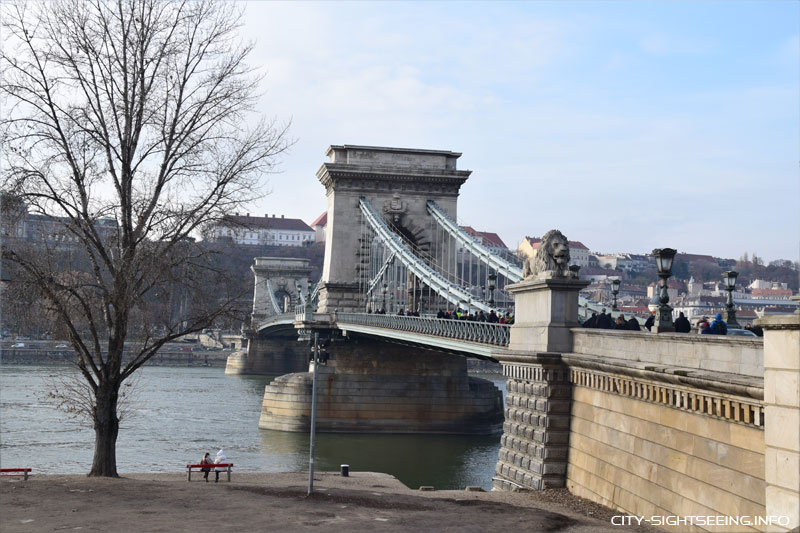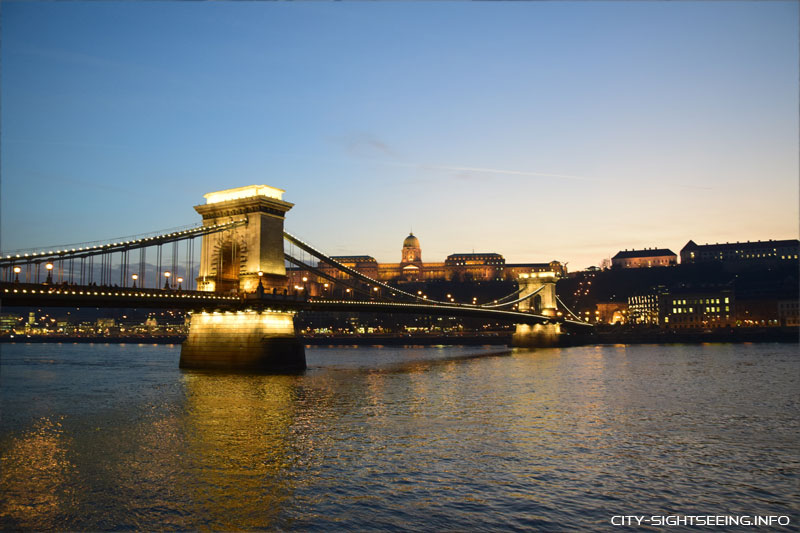Chain Bridge

The Chain Bridge in Budapest, also known as Széchenyi lánchíd, connects the districts of Buda and Pest and is an iconic landmark of the city. Built between 1839 and 1849, it was the first permanent bridge over the Danube and revolutionized traffic. Its technical masterpiece, the hanging chains and classic pillars, made it a symbol of modern Hungarian infrastructure and is now a popular tourist destination.
Table of Contents
Chain Bridge over the Danube
The Chain Bridge in Budapest is a landmark of the city, connecting the districts of Buda and Pest across the Danube. It was built between 1839 and 1849 at the initiative of Hungarian reformer Count István Széchenyi and is the oldest and most famous of the nine road bridges over the river. With a length of 375 meters, it was the largest of its kind in Europe when completed, and remains one of the most important attractions of the Hungarian capital.
The bridge, also known as Széchenyi lánchíd, is a suspension bridge supported by two imposing, classical pillars. Massive iron chains pass through these pillars to support the bridge – hence the name “Chain Bridge.” This structure, weighing about 2,000 tons, was a technical marvel for its time and revolutionized traffic between the two cities. Before the bridge, the connection between Buda and Pest across the river was severely limited in winter, as the pontoon bridge was often destroyed by freezing temperatures.
History and Construction of the Chain Bridge
The idea for the bridge arose after a devastating flood in 1838, which highlighted the need for a permanent Danube crossing. Count Széchenyi, who envisioned a modern Hungarian infrastructure, initiated the founding of the Budapest Bridge Society to finance the construction. Despite initial skepticism from the Viennese government, which favored railway constructions, the construction of the Chain Bridge was pushed forward with private investors. The design was by English engineer William Tierney Clark, with the project managed by Adam Clark.
Work began in 1840, and after years of planning and construction, interrupted by the 1848 revolution, the bridge was officially opened on November 20, 1849. It was the first permanent bridge over the Danube in Budapest and significantly eased trade and traffic. In the following years, the Chain Bridge was expanded and renovated several times to accommodate increasing traffic.
During World War II, the bridge was blown up by the German Wehrmacht in 1945. It was reopened in 1949, just in time for its 100th anniversary, after extensive repairs. In the decades that followed, improvements were made, such as the installation of lighting in 1957 and a new light show in 1999 for the bridge’s 150th anniversary.
The Chain Bridge is not only a technical marvel but also an important national symbol. Many myths and legends surround its creation. A popular story suggests that Count Széchenyi built the bridge to visit his girlfriend in Pest regularly, without having to wade through the water in bad weather. This romantic tale is an expression of the deep cultural significance the bridge holds for Hungarians. It is also seen as a symbol of the dawn of a new era in Hungarian modernization.
Moreover, the Chain Bridge appears in various cultural contexts, such as on stamps and coins, reinforcing its status as a national landmark. After the complete restoration of the bridge in the 20th century, new lighting was installed, making the structure shine in an impressive light at night. The bridge is now not only a functional transport link but also a popular tourist destination and an iconic photo motif.
In addition to the bridge, a tunnel was dug under Castle Hill, planned by Adam Clark, to further improve connections between the districts. Today, the Chain Bridge is used by various modes of transport, and its historical significance is brought to life by its impressive architecture and symbolism.
Chain Bridge at Night
This famous structure in Budapest stands as a symbol of the emergence of national identity. Even at night, like the entire Danube waterfront, it is a sight to behold. Like many other buildings, it is illuminated, giving the Danube bank a special atmosphere. The Széchenyi Lánchíd is thus not only a technical marvel but also a living part of Budapest’s identity and history. It remains one of the city’s most famous landmarks and a central point of urban life.

A visit to this landmark should be on everyone’s list when visiting Budapest.
Address
Budapest, Széchenyi Lánchíd, 1051 Hungary
Tickets





